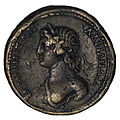Antinous
Salti al navigilo
Salti al serĉilo
English: Antinous (c. 110–130 AD) was the lover of the Roman Emperor Hadrian. Please see also: Category:Antinous.
Français : Antinoüs (c. 110-130 e.c.) fut l'amant de l'empereur romain Hadrien. Voir aussi : Category:Antinous.
Italiano: Antinoo (c. 110–130 d.C.) fu l'amante dell'imperatore romano Adriano. Su di lui si veda anche: Category:Antinous.
Polski: Antinous (około 110–130 n.e.) był kochankiem rzymskiego cesarza Hadriana. Zobacz też: Category:Antinous.
Română: Antinous (n. cca. 110 – d. 130) a fost favoritul împăratului roman Adrian. Vedeți de asemenea Category:Antinous.
Русский: Антиной (около 110—130) — греческий юноша, уроженец малоазийской провинции Вифиния, любовник римского императора Адриана, обожествленный после смерти.
Busts
[redakti]-
Antinous in the National Archaeological Museum in Athens.
-
Antinoo-Bacco - Roma - Musei capitolini.
-
Youngish portrait, Pergamonmuseum in Berlin
-
Same bust
-
Broad-chested Antinous, Pergamonmuseum
-
Same bust, close-up
-
As a child, so-called Temple Antinous, British Museum
-
Glyptothek Munich
-
From the Via dei Fori Imperiali, Centrale Montemartini
-
Antinoos, at the Hermitage Museum
English: From Baniyas in modern Syria. Now in a private collection.
English: A 18th-century copy after an original coming from the villa Adriana, now in the Prado Museum. Now in the Louvre Museum.
-
General view
-
Detail, front
-
In profile
English: Only the chest and cranium are ancient; the head is a modern restoration after known antique portraits of Antinous. From the Ludovisi collection, now in Palazzo Altemps. The original face was later discovered in a separate collection in Chicago.
-
Cast of the Ludovisi-Chicago Antinous from the Art Institute of Chicago
English: The Antinous Mondragone represents Antinous as Dionysos. The head comes from a colossal statue; it was found near the Villa Mondragone, Frascati, between 1712 and 1728. One of the most idealised image of Antinous, it was praised by Winckelmann as "the glory and crown of sculpture. Now in the Louvre Museum.
-
Front
-
In profile
-
Plate from the Nordisk familjebok
-
Bust of the Sala Rotunda, Vatican Museums
-
In situation
-
Profile
Antinous wearing a diadem
[redakti]English: A very childlike representation from Antinous coming from Ostia Antica. Antinous wears a priestly diadem. Now in Palazzo Massimo alle Terme.
Head from the Villa Adriana
[redakti]English: Related to a coin of Adramyttion in Asia Minor. Now in Palazzo Massimo alleĺ Terme.
Antinous as Dionysos
[redakti]English: Origine unknown, ca. 130 AD. Now in the Louvre Museum.
-
Lansdowne Antinous, Fitzwilliam Museum
-
Bust in Louvre
-
Bust in Louvre, from Villa Adriana
-
Cast of the Vatican Antinous-Osiris
-
Cast of the Vatican Antinous-Osiris
Statues
[redakti]-
Bronze statuette from Berlin
-
As Agathodaimon, Berlin
-
Museu Nacional Arqueològic de Tarragona
-
Antinous (Louvre)
So-called “Capitoline Antinous” (actually a portrait of Hermes), from the Villa Adriana in Tivoli, now stored at the Musei Capitolini (Inv. MC 741).
-
Modern restoration of an antique bust after the Capitoline Antinous, Pergamonmuseum in Berlin
-
Modern copy in the Cour Carrée, Louvre
-
Modern copy at the Palazzo Pitti, Florence
-
Cast in the Museum of Fine Arts in Lyons
-
Cast in the Ashmolean Museum, Oxford
-
Cast in the Ashmolean Museum, Oxford
English: Antinous as the Divine Ephebe.
-
General view
-
Detail
English: A reelaboration of the 2nd century AD after a Greek original of the Late Classical period.
-
Ancient picture by Giorgio Sommer
-
Ancient picture by Giorgio Sommer
-
Close-up
-
Close-up
-
Plaster cast from the original in Napoli, Pushkin Museum
As Dionysos
[redakti]Found in 1795 in the imperial villa at Praeneste, now in the Sala Rotunda of the Museo Pio-Clementino, Vatican.
-
Detail of a cast of the original
-
Detail of a cast of the original
Statue of Antinous as Dionysos at the National Archaeological Museum in Naples.
Statue of Antinous as a Dionysiac figure at the Centrale Montemartini in Rome.
-
In the Museo Gregoriano Egiziano
-
In the Museo Gregoriano Egizio (detail)
-
Copy of an original in the Staatliche Sammlung Ägyptischer Kunst München
-
Telamon in the Museo Pio-Clementino
-
Statue from the Athens Archaeological Museum
As a priest
[redakti]-
Antinous as a priest of the imperial cult, Louvre
-
Same work, close-up
Reliefs
[redakti]-
Cast of the Relief from the Villa Albani (Rome).
-
Relief from the Villa Albani (Rome).
-
Relief from the Villa Albani (Rome).
-
Antinous as Dionysos/Silvanus harvesting grapes, signed by Antoninianus of Aphrodisias, Palazzo Massimo alle Terme
-
Antinous as Dionysos/Silvanus (detail), Rome
Medallions
[redakti]-
Lead Roman tesserae from Alexandria
-
Silver medallion from Bithynium-Claudiopolis
-
Bronze medallion from Smyrna
-
Antinous-Hero, medallion from Smyrna
Glyptics
[redakti]-
Sardonyx cameo, ca. 130 AD
Later statues
[redakti]-
From Potsdam, Germany
-
Antinoos with snake, 1852, Potsdam
-
Castle Sanssouci, Potsdam, Germany
-
Fountain of Fellah, Paris
-
Jonah-Antinous in Santa Maria del Popolo, Rome
Paintings
[redakti]-
19th century erotic engraving by Paul Avril












































































































